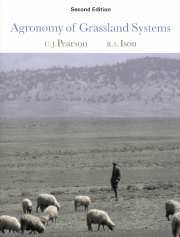Book contents
- Frontmatter
- Contents
- Preface
- 1 Overview: perspectives on grassland systems
- 2 The emergence of grassland systems
- 3 Generation
- 4 Vegetative growth
- 5 Flowering and seed production
- 6 Mineral nutrition
- 7 Herbage quality and animal intake
- 8 Grassland – animal interactions and management
- 9 Grassland systems design
- References
- Index
6 - Mineral nutrition
Published online by Cambridge University Press: 05 June 2012
- Frontmatter
- Contents
- Preface
- 1 Overview: perspectives on grassland systems
- 2 The emergence of grassland systems
- 3 Generation
- 4 Vegetative growth
- 5 Flowering and seed production
- 6 Mineral nutrition
- 7 Herbage quality and animal intake
- 8 Grassland – animal interactions and management
- 9 Grassland systems design
- References
- Index
Summary
Level of organization – and the perspective of the human participants in the grassland system – is particularly important in understanding the mineral nutrition of the system. It is often said that nutrients cycle in a system; it is more apt to suggest that they flow through, and are transformed within, a network. The network may be managed or ignored. Within the network, humans play a maj or role in determining some inputs, particularly fertilizer and where dung and urine are returned on a farm. Humans also choose the levels of some outputs through removal of nutrients in hay, silage, milk, beef, etc., and, implicitly, by controlling or allowing loss of nutrients into adjoining systems, perhaps contributing to eutrification of groundwater or streams and lakes. The management of mineral nutrition of grasslands is particularly challenging because the manager, by operating mostly at the level of the pastoral system (Fig. 1.4) is often unaware of, and usually unable to predict, the long-term impact of human intervention on the functioning of the nutrient network, which is intimately affected by less-visible organisms such as bacteria. Thus, management of nutrition is an arena that increasingly relies on discussion and decision-making at the community, watershed and farm level, as well as for individual fields. This necessitates a range of systemic decision-making aids ranging from participatory consultation to computer-based simulation models (Roling, 1994; van der Meer & van der Putten, 1995).
- Type
- Chapter
- Information
- Agronomy of Grassland Systems , pp. 99 - 118Publisher: Cambridge University PressPrint publication year: 1997
- 1
- Cited by

